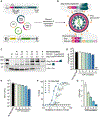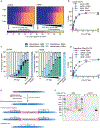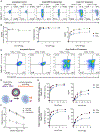Targeted delivery of CRISPR-Cas9 and transgenes enables complex immune cell engineering
- PMID: 34077734
- PMCID: PMC8236216
- DOI: 10.1016/j.celrep.2021.109207
Targeted delivery of CRISPR-Cas9 and transgenes enables complex immune cell engineering
Abstract
As genome engineering advances cell-based therapies, a versatile approach to introducing both CRISPR-Cas9 ribonucleoproteins (RNPs) and therapeutic transgenes into specific cells would be transformative. Autologous T cells expressing a chimeric antigen receptor (CAR) manufactured by viral transduction are approved to treat multiple blood cancers, but additional genetic modifications to alter cell programs will likely be required to treat solid tumors and for allogeneic cellular therapies. We have developed a one-step strategy using engineered lentiviral particles to introduce Cas9 RNPs and a CAR transgene into primary human T cells without electroporation. Furthermore, programming particle tropism allows us to target a specific cell type within a mixed cell population. As a proof-of-concept, we show that HIV-1 envelope targeted particles to edit CD4+ cells while sparing co-cultured CD8+ cells. This adaptable approach to immune cell engineering ex vivo provides a strategy applicable to the genetic modification of targeted somatic cells in vivo.
Keywords: CAR-T cells; CRISPR delivery; CRISPR-Cas9; precision genome editing; viral engineering; virus-like particles.
Copyright © 2021 The Author(s). Published by Elsevier Inc. All rights reserved.
Conflict of interest statement
Declaration of interests The Regents of the University of California have patents issued and pending for CRISPR technologies on which the authors are co-inventors. J.A.D. is a cofounder of Caribou Biosciences, Editas Medicine, Scribe Therapeutics, Intellia Therapeutics, and Mammoth Biosciences. J.A.D. is a scientific advisory board member of Caribou Biosciences, Intellia Therapeutics, eFFECTOR Therapeutics, Scribe Therapeutics, Mammoth Biosciences, Synthego, Algen Biotechnologies, Felix Biosciences, and Inari. J.A.D. is a Director at Johnson & Johnson and Tempus and has research projects sponsored by Biogen, Pfizer, AppleTree Partners, and Roche. A.M. is a compensated co-founder, member of the boards of directors, and a member of the scientific advisory boards of Spotlight Therapeutics and Arsenal Biosciences. A.M. was a compensated member of the scientific advisory board at PACT Pharma and was a compensated advisor to Juno Therapeutics and Trizell. A.M. owns stock in Arsenal Biosciences, Spotlight Therapeutics, and PACT Pharma. A.M. has received honoraria from Merck and Vertex, a consulting fee from AlphaSights, and is an investor in and informal advisor to Offline Ventures. The Marson lab has received research support from Juno Therapeutics, Epinomics, Sanofi, GlaxoSmithKline, Gilead, and Anthem. J.R.H. has consulted for Scribe Therapeutics. All of the other authors have no competing interests.
Figures




Comment in
-
Exploiting HIV-1 tropism to target CD4+ T cells for CRISPR.Immunol Cell Biol. 2021 Aug;99(7):677-679. doi: 10.1111/imcb.12487. Epub 2021 Jul 6. Immunol Cell Biol. 2021. PMID: 34231252 No abstract available.
References
Publication types
MeSH terms
Substances
Grants and funding
LinkOut - more resources
Full Text Sources
Other Literature Sources
Research Materials

